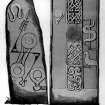Scheduled Maintenance
Please be advised that this website will undergo scheduled maintenance on the following dates: •
Tuesday 3rd December 11:00-15:00
During these times, some services may be temporarily unavailable. We apologise for any inconvenience this may cause.
St Vigeans
Cross Slab (Pictish), Pictish Symbol Stone (Pictish)
Site Name St Vigeans
Classification Cross Slab (Pictish), Pictish Symbol Stone (Pictish)
Canmore ID 35571
Site Number NO64SW 3.02
NGR NO 6383 4294
Datum OSGB36 - NGR
Permalink http://canmore.org.uk/site/35571
- Council Angus
- Parish Arbroath And St Vigeans
- Former Region Tayside
- Former District Angus
- Former County Angus
St Vigeans 2 (St Vigianus), Angus, Pictish cross-slab fragment
Measurements: H 1.18m, W 0.50m, D 0.09m
Stone type: sandstone
Place of discovery: NO c 6384 4289
Present location: in St Vigeans Museum (HES).
Evidence for discovery: found prior to 1770 and re-used as a floor slab in the east staircase of the church. By the 1820s it was lying in the churchyard and by 1903 it had been taken into the church. It was placed in St Vigeans Museum in 1960.
Present condition: worn and the upper part of the slab is missing.
Description
Only face A retains traces of ornament, but face C may have been worn almost entirely smooth. Face A is carved in relief, leaving a plain flat-band border along both vertical edges. The shaft of a cross survives, from its curved shoulder to its base, which extends slightly beyond the lower edge of the main panel. The shaft is bordered by a roll moulding, which at the base turns in on either side to form confronted spirals, with a square of two pairs of double spirals above. Separated from the spirals by a horizontal roll moulding is a panel of heavy diagonal key pattern, itself separated from the panel above by another roll moulding. This upper panel is filled with heavy interlace, which formerly extended into the cross-head. Four Pictish symbols are carved in relief in the background to the cross, two on each side. On the left is a mirror and comb, and to the right a serpent and Z-rod above a very stylised bird of prey.
Date range: eighth to ninth century.
References: ECMS pt 3, 239-40; Fraser 2008, no 67.2; Geddes 2017, no VIG002.
Desk-based information compiled by A Ritchie 2017
Reference (1964)
NO64SW 3.02 6384 4291.
No.2. Cross-slab, top and back missing. The front face has a cross-shaft, the mirror symbol, the serpent and Z-rod, the bird or eagle. This stone is much worn, perhaps in some late re-use as a threshold. Removed from St Vigeans Church to museum, 1960 (NO 6383 4294).
S Cruden 1964
Reference (1997)
Six class II symbol stones.
St Vigeans 1 (The Drosten Stone) : on cross face decoration including an angel with animals and birds and inscription in Hiberno-Saxon script.On the reverse a complex hunting scene with underneath a double-disc and Z-rod over a crescent and mirror-and-comb.
St Vigeans 2 : cross shaft with a mirror on the left and serpent and Z-rod over an eagle on the right.
St Vigeans 3 : fragment with double-disc and Z-rod.
St Vigeans 4 : on the reverse is a standing figure with vertical double-disc on the right.
St Vigeans 5 : fragment with double-disc and Z-rod on the cross face.
St Vigeans 6 : double-disc and Z-rod on one face.
A Mack 1997
























